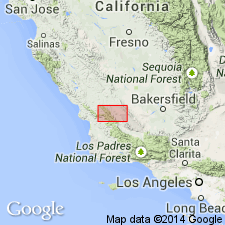
- Usage in publication:
-
- Quail Canyon Sandstone Member*
- Modifications:
-
- Named
- Biostratigraphic dating
- Dominant lithology:
-
- Sandstone
- AAPG geologic province:
-
- California Coast Ranges province
Summary:
Formerly called Soda Lake Sandstone member by Hill and others (1958) in southeast Caliente Range. Here renamed Quail Canyon Sandstone Member of Vaqueros Formation (name Soda Lake used for overlying shale member). Consists of gray-white, massively bedded, fine- to medium-grained, well sorted, firmly indurated sandstone that is commonly cross-bedded. Thickness is 300 ft at type. Conformably overlies Simmler Formation. Age is late Oligocene based on fossils and stratigraphic position. Contains PECTEN MAGNOLIA and other fossils diagnostic of "Vaqueros age" (J. G. Vedder, oral commun., 1968) (Oligocene). According to R.L. Pierce is probably correlative with Agua Sandstone Member of Temblor Formation and Vaqueros Sandstone of Santa Ynez Mountains. Assigned to late Zemorrian, late Oligocene [provincial age, Zemorrian part based on correlations].
Source: GNU records (USGS DDS-6; Menlo GNULEX).

- Usage in publication:
-
- Quail Canyon Sandstone Member*
- Modifications:
-
- Age modified
- AAPG geologic province:
-
- California Coast Ranges province
Summary:
Based on stratigraphic relations age is early Miocene.
Source: GNU records (USGS DDS-6; Menlo GNULEX).
For more information, please contact Nancy Stamm, Geologic Names Committee Secretary.
Asterisk (*) indicates published by U.S. Geological Survey authors.
"No current usage" (†) implies that a name has been abandoned or has fallen into disuse. Former usage and, if known, replacement name given in parentheses ( ).
Slash (/) indicates name conflicts with nomenclatural guidelines (CSN, 1933; ACSN, 1961, 1970; NACSN, 1983, 2005, 2021). May be explained within brackets ([ ]).

